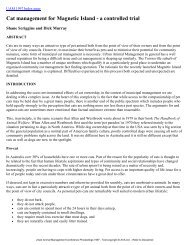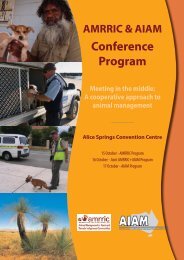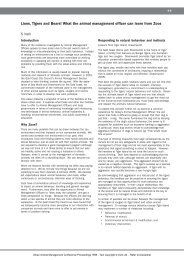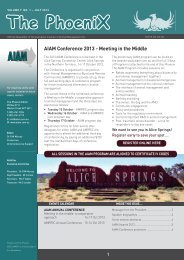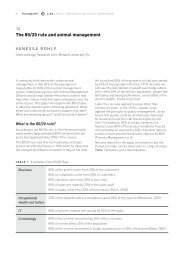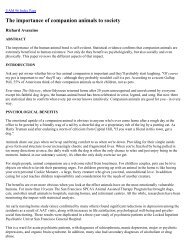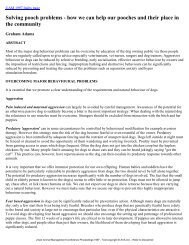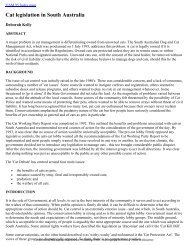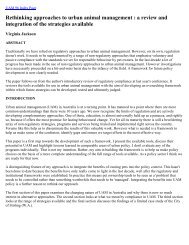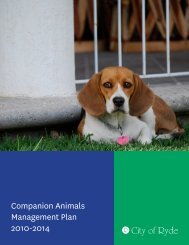Proceedings OF ThE - Australian Institute of Animal Management Inc
Proceedings OF ThE - Australian Institute of Animal Management Inc
Proceedings OF ThE - Australian Institute of Animal Management Inc
Create successful ePaper yourself
Turn your PDF publications into a flip-book with our unique Google optimized e-Paper software.
Annual Conference on <strong>Animal</strong> <strong>Management</strong> AIAM <strong>Proceedings</strong> 2012 73<br />
and stakeholders are structured. Seeking the advice<br />
<strong>of</strong> “in house” council specialist’s staff from the<br />
Community Services area is a great place to begin.<br />
Establish who are the key people, groups and where<br />
natural “hubs” in the community can be found.<br />
Remember that (like most everything else) there is<br />
“no one” community engagement model guaranteed<br />
to succeed, however the tips below in Table 1 may assist.<br />
There is likelihood that some community groups or<br />
members might identify what might be called “non<br />
negotiables” (i.e. things that simply can’t or won’t<br />
be able to be provided). Whilst it’s important that<br />
those consulted are developing a wish list, acting<br />
on these agendas can <strong>of</strong>ten require finite resources<br />
that simply are not available. In mitigating the risk <strong>of</strong><br />
allegations relating to poor community engagement<br />
practises, careful consideration needs to be given<br />
to representation and the level <strong>of</strong> input that are<br />
practical and achievable.<br />
A number <strong>of</strong> methods are available for engaging<br />
people in community planning. Some common<br />
methods are detailed below in Table 2.<br />
Table 1<br />
No Tip Method<br />
1. Build relationships Gain personal trust and presence<br />
2. Go to them Engage with natural community hubs<br />
3. Keep people informed Provide feedback about their input to the plan<br />
4. Maintain balance and focus Remember the “silent majority” are just as important as the vocal groups or individuals<br />
5. Logistics Find neutral venues, hold meetings at an appropriate time <strong>of</strong> day, venues must be easy<br />
to travel to, and have food and drink available.<br />
6. Structure Be upfront about the structure, provide adequate procedures for input, feedback and a<br />
framework for evaluation<br />
7. Facilitation Engage a pr<strong>of</strong>essional facilitator that is over the topic and has the interpersonal skills<br />
in discussing issues with people, information gathering and capacity to assess and<br />
feedback information<br />
8. Accountability The evaluation <strong>of</strong> the engagement process needs to be rigorous and defendable,<br />
workable and simple<br />
9. Ownership Stakeholders must have and perceive ownership <strong>of</strong> the plan<br />
10. Pace Be flexible with timeframes<br />
Table 2<br />
No Method How<br />
1. Working groups Formed from the general community to reflect the demographics <strong>of</strong> the community,<br />
special interest or business groups<br />
2. Workshops Hold at suitable times, usually evening, half day or even full day events. Use <strong>of</strong> a<br />
pr<strong>of</strong>essional facilitator is recommended<br />
3. Public meetings Advertise and manage well<br />
4. Forums Select which particular groups (i.e. youth/seniors etc) because people <strong>of</strong>ten know each<br />
other and issues are focused<br />
5. Surveys Allow a broad cross section <strong>of</strong> the community to have input, other than those who<br />
attend meetings or workshops. There is a risk <strong>of</strong> low return rates and can be expensive<br />
6. Social/media networks Innovative method <strong>of</strong> engagement, they engage different groups in a way that suits them<br />
7. Community conversations Informal discussions are held with relatively small groups <strong>of</strong> people in communities.<br />
They suit situations where there has been previous “over-consultation”, local people<br />
have limited time, issues are particularly contentious or people prefer “kitchen table”<br />
discussions rather than larger meetings<br />
8. Focus groups They provide a comprehensive range <strong>of</strong> views from a small group <strong>of</strong> people<br />
9. Combination <strong>of</strong> methods Engagement should be based on the preferred methods <strong>of</strong> different sectors and<br />
communities according to community “contacts” or discussion with local informed<br />
people. People also need to have multiple opportunities to participate such as a<br />
combination <strong>of</strong> workshops, informal discussions, feedback forms etc.



